Services
Cockroach Control
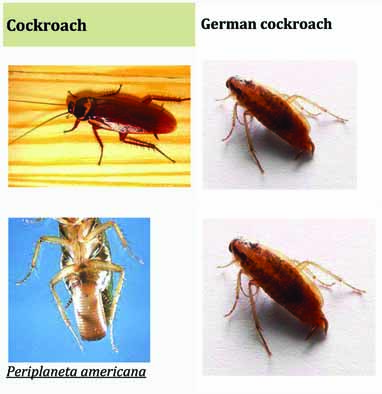 There are about 4,500 species of cockroach, of which 30 species are associated with human habitations
and about four species are well known as pests.
There are about 4,500 species of cockroach, of which 30 species are associated with human habitations
and about four species are well known as pests.
Among the best-known pest species are the American cockroach, Periplaneta americana, which is about 30 millimetres (1.2 in) long, the German cockroach, Blattella germanica, about 15 millimetres (0.59 in) long, the Asian cockroach, Blattella asahinai, also about 15 millimetres (0.59 in) in length, and the Oriental cockroach, Blatta orientalis, about 25 millimetres (0.98 in). Tropical cockroaches are often much bigger and extinct cockroach relatives and 'roachoids' such as the Carboniferous Archimylacris and the Permian Apthoroblattina were not as large as the biggest modern species.
Disease transmission
1. Roaches are a health hazard, carrying bacteria on their bodies that are transmitted to men. The main diseases transmitted are different forms of gastroenteritis including food poisoning, and diarrhea.
Control Method
- Chemical spray method
- Gel method
- Fumigation Method
2. Mosquito Control
 Mosquito (from the Spanish or Portuguese meaning little fly is a common insect in the family Culicidae (from the Latin culex meaning midge or gnat) Mosquitoes resemble crane flies (family Tipulidae) and chironomi flies (family Chironomidae), with which they are sometimes confused by the casual observer.
Mosquito (from the Spanish or Portuguese meaning little fly is a common insect in the family Culicidae (from the Latin culex meaning midge or gnat) Mosquitoes resemble crane flies (family Tipulidae) and chironomi flies (family Chironomidae), with which they are sometimes confused by the casual observer.- There are about 3,500 species of mosquitoes found throughout the world. In some species of mosquito, the females feed on humans, and are therefore vectors for a number of infectious diseases affecting millions of people per year. Some scientists believe that eradicating mosquitoes would not have serious consequences for any ecosystems.
Disease transmission
- Malaria
- Chicken Kuniya
- Encephalitis
- Dengue fever
- Filaria
Control Method
- Chemical spray method
- Snow (Hot) Fogging Method
- Wall spray (Inside House)
Rodent Control
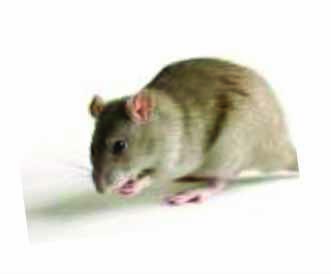 Rats are various medium-sized, long-tailed rodents of the superfamily Muroidea. "True rats" are members of the genus Rattus, the most important of which to humans are the black rat, Rattus rattus, and the brown rat, Rattus norvegicus. Many members of other rodent genera and families are also referred to as rats, and share many characteristics with true rats.
Rats are various medium-sized, long-tailed rodents of the superfamily Muroidea. "True rats" are members of the genus Rattus, the most important of which to humans are the black rat, Rattus rattus, and the brown rat, Rattus norvegicus. Many members of other rodent genera and families are also referred to as rats, and share many characteristics with true rats.
Rats are typically distinguished from mice by their size; rats are generally large muroid rodents, while mice are generally small muroid rodents. The muroid family is very large and complex, and the common terms rat and mouse are not taxonomically specific. Generally, when someone discovers a large muroid, its common name includes the term rat, while if it is small, the name includes the term mouse. Scientifically, the terms are not confined to members of the Rattus and Mus genera, for example the pack rat and cotton mouse.
Disease transmission
Rats can spread disease both directly and indirectly. Food poisoning organisms such as salmonella may be spread via rat faeices and urine. Weil’s disease, a severe and often fatal from of jaundice, is spread, particularly in water (and less often mouse) urine. Mouse faeces may spread tapeworms.
Control Method
- Rat Box (catching) method
- Glue bad Method
- Poison Method (Outer Area Only)
- Fumigation Method
Fly Control
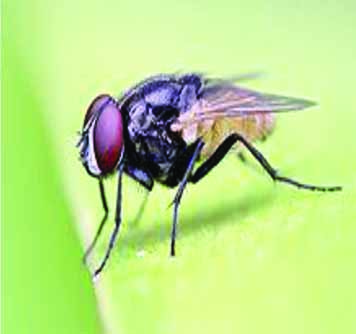 The housefly (also house fly, house-fly or common housefly), Musca domestica, is a fly of the Brachycera suborder. It is the most common of all domestic flies, accounting for about 90% of all flies in human habitations, and indeed one of the most widely distributed insects, found all over the world; it is considered a pest that can carry serious diseases.
The housefly (also house fly, house-fly or common housefly), Musca domestica, is a fly of the Brachycera suborder. It is the most common of all domestic flies, accounting for about 90% of all flies in human habitations, and indeed one of the most widely distributed insects, found all over the world; it is considered a pest that can carry serious diseases.
Housefly as a vector of disease
Mechanical transmission of organisms on its hairs, mouthparts, vomitus and feces:
Disease transmission
- Parasitic diseases: cysts of protozoa
- Bacterial diseases: typhoid, cholera, dysentery, pyogenic cocci
- Viruses: Enteroviruses, poliomyelitis, viral hepatitis
Control Method
- Chemical spray method
- Wall spray Method
- Granules Method
Lizard Control
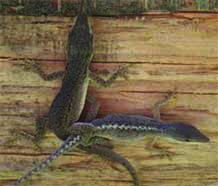 Lizards are a very large and widespread group of squamate reptiles, with nearly 3800 species ranging across all continents except Antarctica as well as most oceanic island chains. The group, traditionally recognized as the suborder Lacertilia, is defined as all extant members of the Lepidosauria (reptiles with overlapping scales), which are neither sphenodonts (i.e., tuatara) nor snakes. While the snakes are recognized as falling phylogenetically within the anguimorph lizards from which they evolved, the sphenodonts are the sister group to the squamates, the larger monophyletic group, which includes both the lizards and the snakes.
Lizards are a very large and widespread group of squamate reptiles, with nearly 3800 species ranging across all continents except Antarctica as well as most oceanic island chains. The group, traditionally recognized as the suborder Lacertilia, is defined as all extant members of the Lepidosauria (reptiles with overlapping scales), which are neither sphenodonts (i.e., tuatara) nor snakes. While the snakes are recognized as falling phylogenetically within the anguimorph lizards from which they evolved, the sphenodonts are the sister group to the squamates, the larger monophyletic group, which includes both the lizards and the snakes.
Lizards typically have limbs and external ears, while snakes lack both these characteristics. However, because they are defined negatively as excluding snakes, lizards have no unique distinguishing characteristic as a group. Lizards and snakes share a movable quadrate bone, distinguishing them from the sphenodonts, which have a more primitive and solid diapsid skull. Many lizards can detach their tails to escape from predators, an act called autotomy, but this trait is not shared by all lizards. Vision, including color vision, is particularly well developed in most lizards, and most communicate with body language or bright colors on their bodies as well as with pheromones. The adult length of species within the suborder ranges from a few centimetres for some chameleons and geckos to nearly three metres (9 feet, 6 inches) in the case of the largest living varanid lizard, the Komodo Dragon. Some extinct varanids reached great size. The extinct aquatic mosasaurs reached 17 metres, and the giant monitor Megalania prisca is estimated to have reached perhaps seven metres
Disease transmission
- Food poison
Control Method
- Chemical spray Method
- Lizard Gum bad Method
- Fumigation Method
Bed Bugs Control
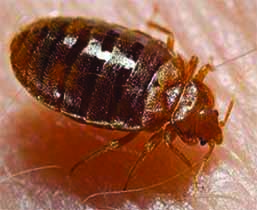 Bedbugs (or bed bugs) are small, elusive, parasitic insects of the family Cimicidae. The term usually refers to species that feed preferentially on human blood; all insects in this family live by feeding exclusively on the blood of warm-blooded animals. The name 'bedbug' is derived from the insect's preferred habitat of infesting houses and especially beds or other common areas where people may sleep. Bedbugs, though not strictly nocturnal, are mainly active at night and are capable of feeding unnoticed on their hosts.
Bedbugs (or bed bugs) are small, elusive, parasitic insects of the family Cimicidae. The term usually refers to species that feed preferentially on human blood; all insects in this family live by feeding exclusively on the blood of warm-blooded animals. The name 'bedbug' is derived from the insect's preferred habitat of infesting houses and especially beds or other common areas where people may sleep. Bedbugs, though not strictly nocturnal, are mainly active at night and are capable of feeding unnoticed on their hosts.
Bedbugs have been known by a variety of names including wall louse, mahogany flat, crimson rambler, heavy dragoon, chinche and redcoat.
Largely eradicated as pests in the developed world (largely through the use of DDT) in the early 1940s, bedbugs have been resurgent since about 1995.
Disease transmission
Bedbugs would seem to have all the prerequisites for passing diseases from one host to another, and at least twenty-seven known pathogens (some estimates are as high as forty-one) are capable of living inside a bedbug or on its mouthparts, yet there are no known cases of such transmission. Extensive laboratory testing indicates that bedbugs are unlikely to pass disease from one person to another.
Control Method
- Chemical spray method
- Oil spray method (All Wooden parts)
Spider control
 Spiders (order Araneae) are air-breathing arthropods that have eight legs, and chelicerae with fangs that inject venom. They are the largest order of arachnids and rank seventh in total species diversity among all other groups of organisms. Spiders are found worldwide on every continent except for Antarctica, and have become established in nearly every habitat with the exception of air and sea colonization. As of 2008, approximately 40,000 spider species, and 109 families have been recorded by taxonomists; however, there has been confusion within the scientific community as to how all these families should be classified, as evidenced by the over 20 different classifications that have been proposed since 1900.
Spiders (order Araneae) are air-breathing arthropods that have eight legs, and chelicerae with fangs that inject venom. They are the largest order of arachnids and rank seventh in total species diversity among all other groups of organisms. Spiders are found worldwide on every continent except for Antarctica, and have become established in nearly every habitat with the exception of air and sea colonization. As of 2008, approximately 40,000 spider species, and 109 families have been recorded by taxonomists; however, there has been confusion within the scientific community as to how all these families should be classified, as evidenced by the over 20 different classifications that have been proposed since 1900.
Disease transmission
- Pain & skin allergy
Control Method
- Chemical spray method
- Oil spray method (All Wooden parts)
